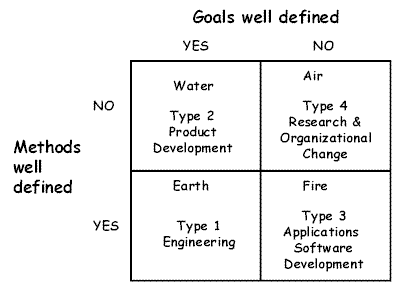|
Since the planning approach we
adopt for a project depends upon the type of project we have, we need to address this
issue. An interesting way to classify
projects (attributed to J.R. Turner and R.A. Cochrane 1993) is to consider two critical aspects of the project:
- the objectives
- the methods to be used in the
project
This will give four combinations
as shown in the diagram below.

Examining
projects this way will help us to select the appropriate planning process
and to understand the problems we may encounter in that process. Return
to top of page
Earth - Type 1
- Engineering Project
In type 1 projects both the goals
and the methods are well defined. Examples of type 1 projects are large
engineering projects, labeled here as "Earth" projects because they have a
"good foundation" Since both the goals and methods are
well defined and supported by considerable experience and well tested
methodology this type of project has a high probability of success.
Return
to top of page
Water - Type 2
- Product Development Projects
In type 2 the goals are well
defined but the methods by which they will be achieved are not. They are
typified by product development work which flow like turbulent rivers
with a sense of purpose but apparently haphazard. They are characterized
as "water" projects.
Fire - Type 3
- Software Development Projects
In type 3 projects the goals are
not well defined but the methods are. For example, in software development projects,
goals are often not specified precisely at the start of the project.
These become defined as the product develops and as alpha and beta
versions of the product are tested on prospective users. These have been labeled "fire "projects. They
generate a lot of heat and can burn with no apparent purpose.
Return
to top of page
Air - Type 4 - Organizational Development
In type 4 projects neither the
goals or the methods are well defined at the start of the project. They
are typified by organization development projects and called "air"
projects because they are so difficult to get hold of and deliver
"blue-sky" research objectives.
|